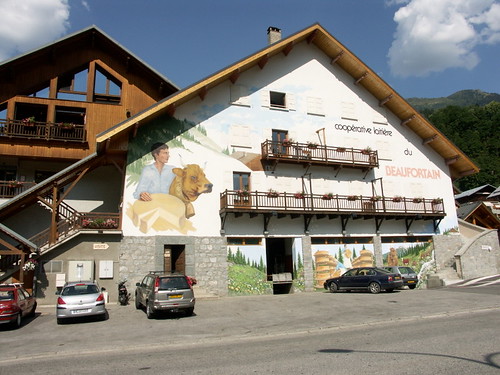A small reportage from our visit to a cheese making farm
Living in a country which produces more than 300 varieties of cheese*, it is only natural that I write a little bit about cheese. It took me years to really like cheese as I have never been fond of dairy products back then when I lived in Indonesia. Even now, I still can not understand why french people (ex. my hubby) enjoy eating the fromage qui pue (a smelly cheese), blue cheese or runny Camembert. I have a preference for a cooked pressed cheese. Beaufort is one of them, my favorite one.
The main ingredient of a cheese is milk, be it from a cow, sheep or goat. Cheese is made by curdling milk either by acidulation - by addition of vinegar as well as lemon juice, or by the natural acidulation - by the addition of bacteria. The addition of specific bacterium assists the conversion of milk sugar into lactic acid, the acidulation stage, followed by the addition of rennet to complete the curdling process.
Cheeses are available in a variety of style and flavours. Their character and physical appearance depending on the region they come from, the type of milk used, the strains of bacteria and mould used, the differing levels of fat, length of time left to age, the differing methods of production, or even depending on which field the animals have grazed.
Beaufort is made with the milk of cows raised in the high pastures of the Savoie stretching over the Beaufortain, Tarentaise, Maurienne, and part of the Val d'Arly regions. It owes its creamy fruity character to the milk of herds grazing on these high Alps pastures. Cellar aged for 18 months, these cheese develops a deep richness and concentration of flavors. The wheels are turned regularly to allow its natural reddish brown rind to develop. Dense and buttery with a nutty finish which is balanced by a slight sweetness, Beaufort is sometimes referred to as the "Prince of Gruyeres."
Here are the different stages of Beaufort cheese transformation (excerpt from this site):
Curdling or coagulation
At 33°C, for coagulation, the cheese-maker adds the rennet, prepared according to an ancestral method which is used as a lactic leaven agent.
Breaking up the curd
With the help of a "curd slicer", the cheese-maker cuts the resulting curd into small grain-size pieces. This process helps eliminate a large quantity of water from the curd.
Stirring and cooking
The grains are then heated to 53-54°C and continually stirred. This stage, called "stirring on the fire", is perfect for the draining of the grain.

Moulding and pressing
When it is felt that the curd is "done", the cheese-maker removes it from the cauldron and places it in a cheesecloth. He then presses the cheeseclothed curd in a round wooden mould which gives it its characteristic concave heel. The cheese is turned over and pressed during a 20 hour period.
Salting
After resting it for 24 hours, the cheese is placed in a bath of brine for a first salting, which contributes to its rind.

Maturing
The maturing of Beaufort lasts a minimum of 5 months and sometimes upto 12 months and longer. At a temperature of less than 10°C and increased humidity, the quality of the final product is largely dependent upon the care which the cheese-maker and cellarman bring to their craft. He salts, rubs and turns the cheeses twice per week, conditions essential for the development of the cheese's aromas.
Voilà, now eat cheeeese!
*Former president Charles de Gaulle once said: "How can you govern a country in which there are 246 kinds of cheese?"

9 comments:
I just only know few kind of cheese..Mozarela, gouda, edam, parmesan, n cheddar cheese, the first three considered expensive...the last one was daily used cheese the affordable one ...
dairy products here are ...hhhmm...still luxurious for some people...:-(
none of them are french unfortunately :-)
it's true truemom...
di sini cheese emang mahal... :(
di sini juga sih djeung Les, tapi udah jadi olahraga eh makanan national
wahh tes tes dong ...yummyyyy
Kesukaan my boys tuh....cheese
kalo si celia doyan juga smelly cheese, Lis?
di sini mah lucu lis, kita disuruh membudayakan kebiasaan mengkonsumsi susu dan segala produk olahannya. tapi, buat banyak orang, boro2 buat beli susu. beli beras aja udah ngos2an... :(
coba mbak Yanti, di sana banyaknya keju apa ?
Sylvia, senangnya keju yg tipe apa ?
Ngga bek, Célia demennya yg spt mamanya beaufort, gouda yg dari belanda
Post a Comment